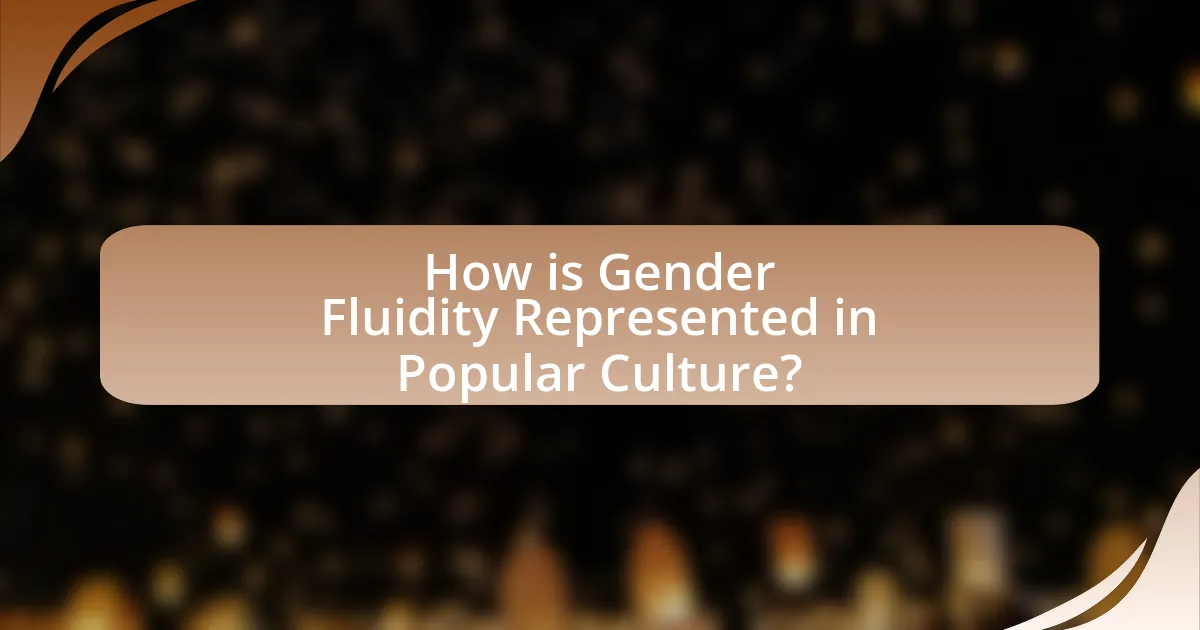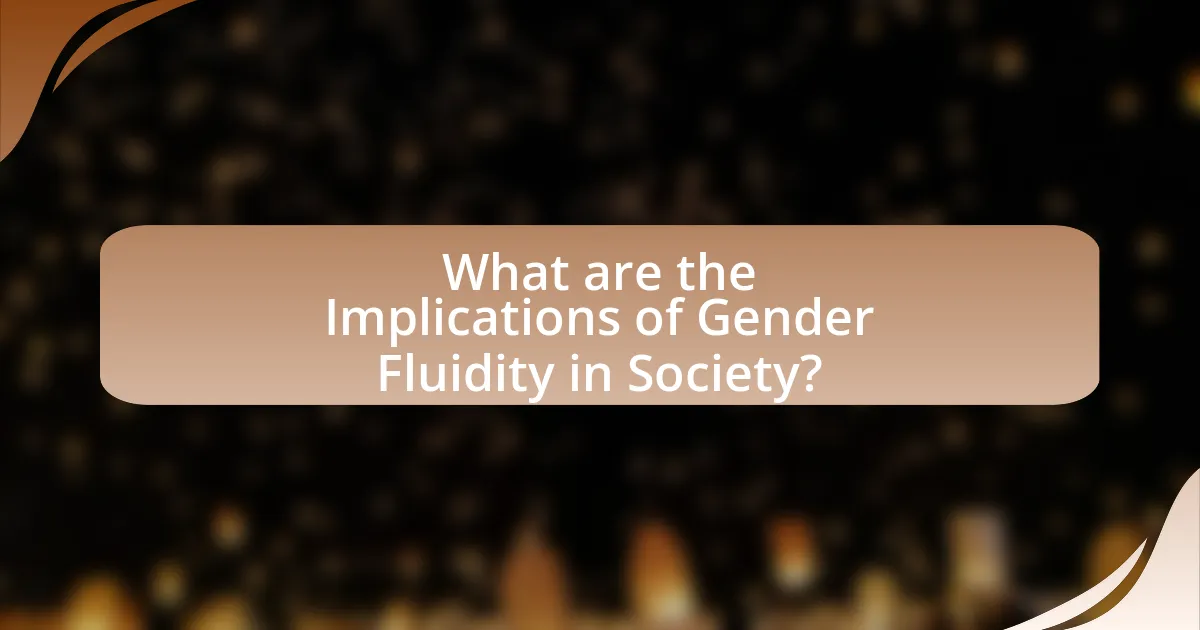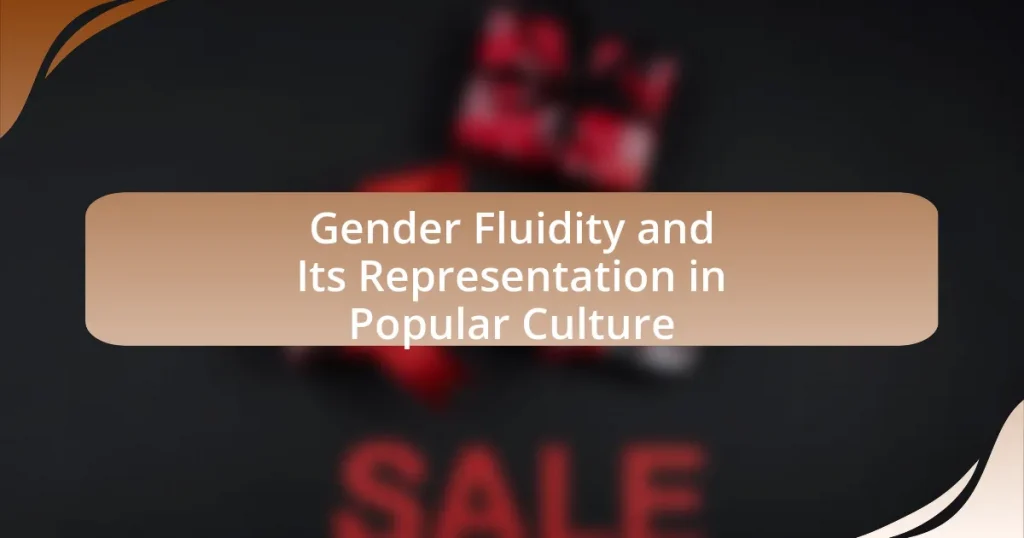Gender fluidity is a gender identity characterized by a flexible experience of gender, allowing individuals to identify as male, female, both, neither, or shift between these identities over time. This article explores the definition and characteristics of gender fluidity, its distinction from other gender identities, and its significance in contemporary society. It examines the representation of gender fluidity in popular culture, including media, music, and fashion, highlighting notable examples and the impact of visibility on societal perceptions. Additionally, the article discusses the challenges faced by gender fluid individuals and practical ways to foster inclusivity and support within communities.

What is Gender Fluidity?
Gender fluidity is a gender identity that allows for a flexible experience of gender, where an individual may identify as male, female, both, neither, or move between these identities over time. This concept challenges the traditional binary understanding of gender, recognizing that gender can be a spectrum rather than a fixed category. Research indicates that gender fluid individuals may express their gender differently depending on various factors, including social context and personal feelings, which highlights the dynamic nature of gender identity.
How is gender fluidity defined in contemporary society?
Gender fluidity in contemporary society is defined as a gender identity that is not fixed and can change over time, encompassing a spectrum of gender expressions beyond the traditional binary of male and female. This definition is supported by the increasing recognition of diverse gender identities in social discourse, legal frameworks, and cultural representations, as evidenced by the inclusion of gender fluid individuals in media and advocacy for non-binary rights. Research from the American Psychological Association highlights that gender fluidity reflects the complexity of human identity and challenges rigid gender norms, emphasizing the importance of personal experience in defining one’s gender.
What are the key characteristics of gender fluidity?
Gender fluidity is characterized by a flexible understanding of gender identity that can change over time or depending on the context. Individuals who identify as gender fluid may experience shifts between traditional gender categories, such as male and female, or may identify outside these binary classifications altogether. This fluidity can manifest in various ways, including changes in gender expression, pronoun usage, and self-identification. Research indicates that gender fluidity challenges rigid gender norms and promotes a more inclusive understanding of gender, as seen in studies like “Gender Fluidity: A New Perspective on Gender Identity” published in the Journal of Gender Studies, which highlights the diverse experiences of gender fluid individuals and their impact on societal perceptions of gender.
How does gender fluidity differ from other gender identities?
Gender fluidity differs from other gender identities in that it encompasses a dynamic and flexible experience of gender, allowing individuals to identify with multiple genders or shift between them over time. Unlike fixed identities such as male or female, gender fluidity recognizes that gender can be non-binary and changeable, reflecting a spectrum rather than a binary classification. This concept is supported by research indicating that many individuals experience their gender identity as fluid, which contrasts with more static identities that are often defined by societal norms.
Why is understanding gender fluidity important?
Understanding gender fluidity is important because it fosters inclusivity and respect for diverse identities. Recognizing that gender is not strictly binary allows individuals to express themselves authentically, which can lead to improved mental health outcomes. Research indicates that individuals who identify as gender fluid often experience higher levels of acceptance and lower rates of anxiety and depression when their identities are acknowledged and validated. For instance, a study published in the Journal of Adolescent Health found that LGBTQ+ youth, including those who identify as gender fluid, reported better well-being when they felt supported by their peers and families. This understanding promotes a more equitable society where all individuals can thrive without the constraints of traditional gender norms.
What impact does gender fluidity have on individual identity?
Gender fluidity significantly impacts individual identity by allowing people to express their gender in a way that aligns with their personal experience rather than conforming to traditional binary norms. This flexibility fosters a sense of authenticity and self-acceptance, as individuals can navigate their gender identity in a manner that feels true to them. Research indicates that individuals who identify as gender fluid often report higher levels of self-esteem and well-being, as they are not constrained by societal expectations (Budge, Adelson, & Howard, 2013, Journal of Consulting and Clinical Psychology). This empowerment can lead to greater visibility and representation in popular culture, further validating diverse identities and challenging stereotypes.
How does gender fluidity challenge traditional gender norms?
Gender fluidity challenges traditional gender norms by rejecting the binary classification of gender as strictly male or female. This fluidity allows individuals to express their gender identity in a way that may shift over time, thereby undermining the rigid expectations associated with traditional gender roles. For instance, research indicates that individuals who identify as gender fluid often navigate and embody a spectrum of gender expressions, which can disrupt societal norms that dictate specific behaviors, clothing, and roles for men and women. This challenge is evident in popular culture, where representations of gender fluidity in media and art promote broader acceptance and understanding of diverse gender identities, further questioning the validity of traditional gender norms.

How is Gender Fluidity Represented in Popular Culture?
Gender fluidity is represented in popular culture through various media, including television, film, music, and fashion, showcasing characters and public figures who embody non-binary identities. For instance, television shows like “Billions” feature characters such as Taylor Mason, who identifies as gender non-binary, reflecting a broader acceptance and visibility of gender fluidity. Additionally, artists like Sam Smith and Janelle Monáe openly discuss their gender identities in interviews and music, further normalizing the conversation around gender fluidity. This representation is supported by research indicating that increased visibility in media correlates with greater societal acceptance of diverse gender identities, as highlighted in studies by the Williams Institute.
What are some notable examples of gender fluidity in media?
Notable examples of gender fluidity in media include characters like David Bowie’s Ziggy Stardust, who challenged traditional gender norms through androgynous fashion and performance. Additionally, the animated series “Steven Universe” features characters like Stevonnie, who embodies a blend of genders, reflecting fluidity in identity. The film “The Danish Girl” portrays Lili Elbe, one of the first known recipients of gender confirmation surgery, highlighting historical aspects of gender fluidity. These representations in media not only showcase diverse gender identities but also contribute to broader societal discussions about gender fluidity.
How do films portray gender fluid characters?
Films portray gender fluid characters by depicting them as individuals who navigate and express their gender identity beyond traditional binary norms. This representation often includes characters who shift between masculine and feminine traits, challenging societal expectations and stereotypes. For instance, films like “The Danish Girl” and “Moonlight” illustrate the complexities of gender fluidity through their protagonists’ journeys, showcasing emotional depth and personal struggles. These portrayals contribute to broader conversations about gender identity, as evidenced by increased visibility and acceptance of gender fluid characters in contemporary cinema, reflecting a shift in cultural attitudes towards gender diversity.
What role do television shows play in depicting gender fluidity?
Television shows play a significant role in depicting gender fluidity by providing visibility and representation for non-binary and gender non-conforming characters. These shows challenge traditional gender norms and promote understanding by showcasing diverse experiences of gender identity. For instance, series like “Billions” feature characters such as Taylor Mason, who identifies as non-binary, thereby normalizing gender fluidity in mainstream media. Research indicates that representation in media can positively influence societal attitudes towards gender diversity, as seen in studies by the Williams Institute, which highlight the impact of visibility on acceptance and understanding of LGBTQ+ identities.
How do music and fashion reflect gender fluidity?
Music and fashion reflect gender fluidity by challenging traditional gender norms and promoting self-expression beyond binary classifications. Artists like David Bowie and Prince have historically blurred gender lines through their androgynous styles and performances, influencing contemporary musicians such as Harry Styles and Lil Nas X, who embrace fluidity in their fashion choices and public personas. Fashion designers like Jean-Paul Gaultier and brands like Gucci have also embraced gender-neutral clothing, further normalizing the concept of gender fluidity in everyday attire. This cultural shift is evidenced by the increasing visibility of non-binary and gender-fluid individuals in both industries, showcasing a broader acceptance and celebration of diverse gender identities.
What artists have embraced gender fluidity in their work?
Artists who have embraced gender fluidity in their work include David Bowie, Prince, and Janelle Monáe. David Bowie, known for his alter ego Ziggy Stardust, challenged traditional gender norms in the 1970s, blending masculinity and femininity in his music and persona. Prince frequently blurred gender lines through his fashion choices and lyrics, promoting a fluid understanding of identity. Janelle Monáe has openly identified as non-binary and incorporates themes of gender fluidity in her music and visual art, particularly in her album “Dirty Computer,” which explores identity and self-expression. These artists have significantly influenced popular culture by redefining gender boundaries and promoting acceptance of diverse identities.
How has fashion evolved to include gender fluid expressions?
Fashion has evolved to include gender fluid expressions by increasingly embracing non-binary aesthetics and breaking traditional gender norms. This shift is evident in the rise of unisex clothing lines, such as those launched by brands like Telfar and Rad Hourani, which offer styles that cater to all genders. Additionally, high-profile figures like Billy Porter and Jaden Smith have popularized gender fluid fashion on global platforms, challenging societal expectations and encouraging inclusivity. The 2010s saw a significant cultural shift, with events like the introduction of gender-neutral categories at major fashion awards, reflecting a broader acceptance of diverse gender identities in the fashion industry.

What are the Implications of Gender Fluidity in Society?
The implications of gender fluidity in society include increased visibility and acceptance of diverse gender identities, which challenge traditional binary notions of gender. This shift fosters a more inclusive environment, allowing individuals to express their identities freely without fear of discrimination. Research indicates that societies embracing gender fluidity experience lower rates of mental health issues among LGBTQ+ individuals, as seen in studies published by the American Psychological Association, which highlight the positive effects of acceptance on well-being. Furthermore, gender fluidity influences cultural norms, prompting changes in language, fashion, and media representation, thereby reshaping societal perceptions of gender roles and expectations.
How does gender fluidity influence social perceptions of gender?
Gender fluidity significantly influences social perceptions of gender by challenging traditional binary notions and promoting a more inclusive understanding of identity. This shift encourages society to recognize that gender is not fixed and can vary over time, leading to greater acceptance of diverse gender expressions. Research indicates that exposure to gender fluid individuals in media and popular culture, such as the representation of non-binary characters in television shows, fosters empathy and reduces stigma, as seen in studies like “The Impact of Media Representation on Gender Identity” published in the Journal of Gender Studies. This evolving perception contributes to a broader societal dialogue about gender, ultimately reshaping norms and expectations surrounding gender identity.
What challenges do gender fluid individuals face in society?
Gender fluid individuals face significant challenges in society, including discrimination, lack of understanding, and limited access to appropriate healthcare. Discrimination manifests in various forms, such as verbal harassment, physical violence, and systemic bias in workplaces and educational institutions. A study by the Human Rights Campaign found that 46% of gender non-conforming individuals reported being harassed in public spaces. Additionally, societal misunderstanding often leads to misgendering and invalidation of their identities, which can contribute to mental health issues. Access to healthcare is also problematic, as many medical professionals lack training on gender fluidity, resulting in inadequate support and resources. These challenges highlight the need for greater awareness and acceptance of gender fluid identities in society.
How can society become more inclusive of gender fluidity?
Society can become more inclusive of gender fluidity by implementing comprehensive education programs that promote understanding and acceptance of diverse gender identities. These programs should be integrated into school curricula and community workshops to raise awareness about gender fluidity, helping to dismantle stereotypes and misconceptions. Research indicates that inclusive education can significantly reduce bullying and discrimination; for instance, a study by GLSEN found that LGBTQ+ inclusive curricula lead to safer school environments for all students. Additionally, legal recognition of non-binary and gender fluid identities in official documents, such as identification cards and passports, can further validate these identities and promote societal acceptance.
What role does education play in understanding gender fluidity?
Education plays a crucial role in understanding gender fluidity by providing individuals with knowledge about diverse gender identities and expressions. Through comprehensive curricula that include discussions on gender theory, history, and the experiences of gender-fluid individuals, education fosters awareness and empathy. Research indicates that educational programs addressing gender diversity can reduce stigma and promote acceptance, as seen in studies like “The Impact of Gender Education on Attitudes Toward Gender Nonconformity” published in the Journal of Educational Psychology, which found that students exposed to gender diversity education exhibited more inclusive attitudes. Thus, education serves as a foundational tool for enhancing understanding and acceptance of gender fluidity in society.
How can schools promote awareness of gender fluidity?
Schools can promote awareness of gender fluidity by implementing inclusive curricula that educate students about diverse gender identities. This can include lessons on gender fluidity, discussions about the spectrum of gender, and the importance of respecting individuals’ self-identifications. Research indicates that inclusive education can reduce bullying and discrimination, fostering a safer environment for all students. For instance, a study published in the Journal of School Psychology found that schools with comprehensive anti-bullying programs that include discussions on gender diversity see a significant decrease in incidents of harassment. By integrating these educational practices, schools can create a more accepting atmosphere that acknowledges and respects gender fluidity.
What resources are available for learning about gender fluidity?
Resources available for learning about gender fluidity include books, academic articles, online courses, and community organizations. Notable books such as “Gender Outlaws: The Next Generation” by Kate Bornstein and S. Bear Bergman provide personal narratives and theoretical insights. Academic articles, like “Gender Fluidity: A Review of the Literature” published in the Journal of Gender Studies, offer research-based perspectives. Online platforms such as Coursera and Udemy feature courses on gender identity, including modules specifically addressing gender fluidity. Additionally, organizations like Gender Spectrum and The Trevor Project provide educational resources and support for understanding gender diversity. These resources collectively enhance knowledge and awareness of gender fluidity in contemporary society.
What are practical ways to support gender fluid individuals?
Practical ways to support gender fluid individuals include using their chosen names and pronouns consistently, creating inclusive environments, and advocating for their rights. Using correct names and pronouns fosters respect and validation, which is crucial for their mental well-being. Creating inclusive environments, such as gender-neutral restrooms and safe spaces, helps gender fluid individuals feel accepted and comfortable. Advocacy for their rights, including support for policies that protect against discrimination, is essential for promoting equality and visibility. Research indicates that supportive environments significantly reduce mental health issues among gender diverse individuals, highlighting the importance of these practical measures.
How can friends and family provide support to gender fluid individuals?
Friends and family can provide support to gender fluid individuals by actively affirming their identity and using their chosen name and pronouns. This affirmation is crucial as studies show that individuals who receive support from family and friends report higher levels of mental well-being and lower rates of depression and anxiety. Additionally, friends and family can educate themselves about gender fluidity to better understand the experiences and challenges faced by gender fluid individuals, fostering an environment of acceptance and respect. Engaging in open conversations and listening to the individual’s needs further strengthens this support system, as research indicates that communication is key in building trust and understanding within relationships.
What actions can communities take to foster inclusivity for gender fluidity?
Communities can foster inclusivity for gender fluidity by implementing educational programs that promote understanding and acceptance of diverse gender identities. These programs can include workshops, seminars, and discussions that address the experiences and challenges faced by gender fluid individuals, thereby increasing awareness and empathy among community members. Research indicates that education significantly reduces prejudice and fosters a more inclusive environment, as seen in studies conducted by the Human Rights Campaign, which highlight the positive impact of awareness initiatives on community attitudes towards LGBTQ+ individuals. Additionally, communities can create safe spaces, such as support groups and inclusive events, where gender fluid individuals can express themselves freely and connect with others, further reinforcing a culture of acceptance and support.










